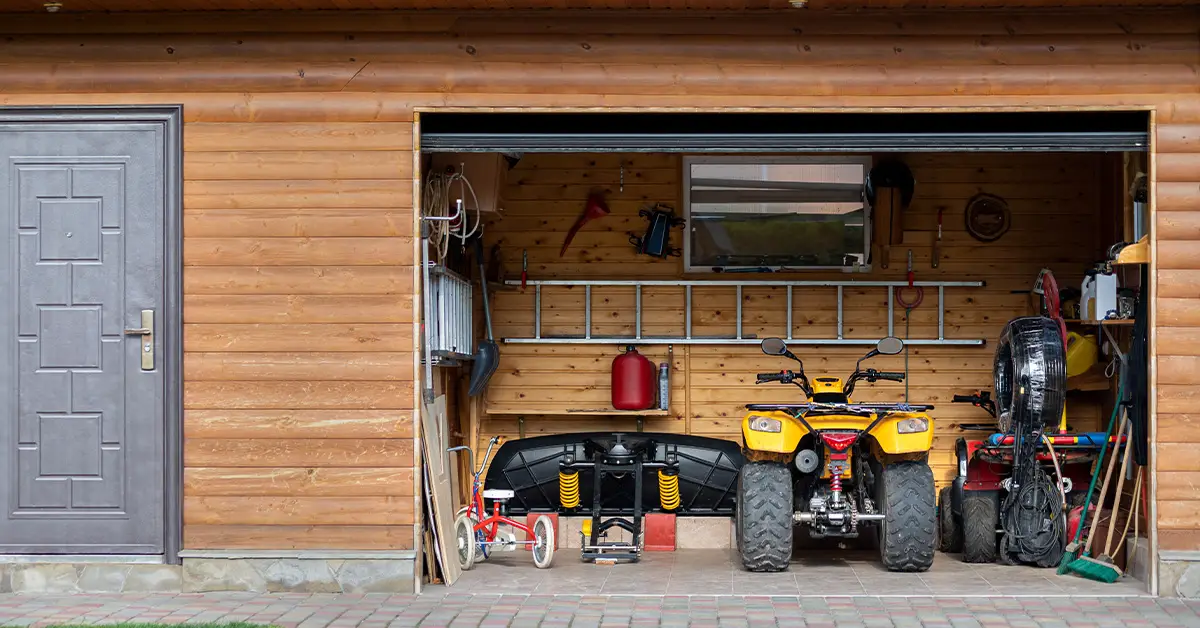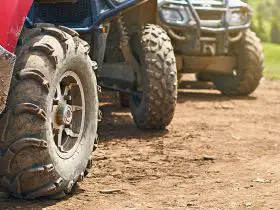ATV engines are similar to almost every vehicle. They have different options to offer but still work with the same gasoline and components called fuel-air ratios. As a person interested in studying ATV engines, its functionality may somehow have crossed your mind already. Or perhaps, you’re having difficulty constantly monitoring your ATV engine. Either way, let this guide help you.
Table of Contents
Understanding ATV Engine and Its Types
ATV engines function by drawing fuel and oxygen into the combustor, enabling the piston to squeeze upward and ignite the mixture. When the vehicle is propelled forward and then backward, there is a controlled explosion that releases exhaust in the output end. ATVs are powered by two and four-stroke engines, respectively.
Two-stroke engines are less practical in ATVs since they generate power each time the cylinder reaches the combustor. Yet, this engine delivers more power and weighs less than the other at the same time. There’s no oil tank, which means less upkeep and more freedom to appreciate your investment.
The engine of a four-stroke ATV, on the other hand, necessitates frequent oil changes. Due to their lower RPMs and minor wear on the four-stroke, they’re thought to be more effective than two-stroke engines. In addition, you can combine oil and gasoline before each use.
How ATV Functions
1. The fuel pump squirts fuel into the combustor. The injectors and fuel pump deliver the gasoline needed to meet the inlet port valve’s oxygen. When the ratio is proper, clean energy is produced. Though, misfires can occur if either side makes a mistake.
2. The crankshaft pushes the cylinder into the combustor. The piston then pulls up and pressures the gasoline and air. Because the combustion chamber is small, things get heated quickly.
3. Explosion generates electricity and propels the vehicle. This is based on ATV.com‘s data. It’s a thundering, controlled explosion. That’s the sound you perceive when you start or accelerate.
4. The exhaust is discharged to avoid clogging. Your exhaust pipe pushes out the stuff. Thus it’s usually covered in soot. Insufficient exhaust pipe cleaning might lead to overheating. Make sure to wash the filters to avoid clogging and incorrect fuel-air ratios.
5. This cycle needs two to four beats based on the engine type. The fundamental distinction between these two and four propellers is the number of repeats. Two-stroke engines require two impulses, while the other engines require four.
ATV Engine Timing
The ATV engine Timing refers to the proper and correct process sequence that is needed to happen for the motor to function. Like a normal bicycle with cogs, the ATV needs to have all of its parts working in the proper sequence. If one component starts to get out of sync, the valvetrain can not be able to work with the piston and crank – making the quad dead.
To diagnose this, you will need to identify the symptoms by examining your cam sprocket position. You can detach the camshaft cover and spark plugs. When the cam sprocket is often not parallel with the timing directions at Top Dead Center, it means that your quad has jumped the time.
This article will talk about how you can set the cam sprocket towards the proper position while ensuring the can lobes because that alone will solve your problem. But first, let’s get to know the roots of the issue.
Symptoms of Bad Timing
There are reasons why an ATV engine isn’t sounding or operating as it should be. The timing is not usually among the first things to be inspected unless it exhibits one or more of the symptoms listed:
- No power
- Backfiring
- Popping in carburetor
- Poor idle
- No start
- Engine binding crank
- Long crank
- Hit starting issues
- Won’t rev
Don’t rule out a few of the apparent factors first, which include the following factors:
- Wrong plug type
- Fouled spark plugs
- Faulty CDI
- Bad gas
- Valve lash that needs adjustments
- Faulty coil
- Faulty stator
- Faulty/misaligned pickup
- Fault in flywheel magnet position
- Missing or sheared flywheel key
Checking the Timing
Checking the engine synchronization is an easy task, but you’ll most likely have to eliminate a few items from your workspace in order to do it effectively. Suppose that your motor is also an Over Head Cam as it can be found in nearly all modern ATVs. This included both a single-cam and a twin-cam setup; your timing notation will most likely be unique but don’t worry, the pacing flow charts below should give you a good idea of what to expect.
This is how the procedure works:
Step 1: Begin the operation by removing the spark plug in the ATV engine. This will make the cranking issue in the motor easier. After that, go and remove the inspection hole in timing.
Step 2: Rotate the flywheel slowly in the direction counterclockwise by using a ratchet and suitable socket. The “T” mark on it or another symbol equivalent should appear in the window inspection. Know that it indicates TDC or Top Dead Center. You may also need to detach the pull starter assembly if you can to inspect the timing hole.
Step 3: In the third step, you can finally remove the camshaft inspection cover. If you didn’t know, it might be a crankshaft set with a single cam engine. Check the marking located on the cam timing sprocket. Then, see if it aligns with the cylinder head mark.
On the other hand, if your engine is a twin-cam, don’t worry because it has almost the same process. All that’s different is the extra sprocket mark to be aligned. Since both sprockets typically align in the horizon plain and may have additional marks. Both should point upwards.
Step 4. If the timing marks on the cam sprockets do not line up, crank the flywheel in the direction of the counterclockwise around until they do. Once more, center the “T” or comparable TDC crankshaft symbol in the inspection framework.
Once the sprocket marks are matched on the head (horizontal flat of the crankcase, the extra cam signs extending upwards 90° should be matched on the head (if applicable). On the compression stroke, the motor is now adjusted to TDC (top dead center).
If none of the cam timing symbols line up, your timing is incorrect and will have to be fixed.
How to Know if the Engine Timing Jumped
Perhaps the clearest sign that the ATV engine timing jumped is when it won’t start. You may hear the engine turning over but still won’t start. It can be caused by other common issues. You can check the other parts by creating the spark plug, fuel filter, carburetor, and fuel pump.
If you eliminate the other causes, you can turn the camshaft and examine the timing. First off, you can check this by scanning the guidelines provided in the instructions as it is the most precise way to fix it. However, if you can’t find the manual, you may ask for assistance from a professional.
Resetting AVT Engine Timing
Rebooting the timing might be a hassle, but it is essential that you do it right the first time. It is possible that the piston will strike the valves, resulting in highly costly repairs if the synchronization is not precise. What you should do is locate a guidebook for your motor.
The procedure, torque specifications, and clamping sequences differ from one engine to another. A torque wrench, as well as knowledge of your timing markings and torque standards, as well as fastener sequences, will be required. This is how you can reset the time manually.
- Remove the cam covers and set the shaft and sprockets at TDC on the compression stroke.
- Take the tensioner from the system.
- Withdraw the chain out from the cam sprocket(s) and keep it in place while you work.
- Adjust the sprocket to its proper position
- Reinstall the chain.
- Reload the tensioner by screwing it back in place.
- Install the tensioner and replacement gasket, then tighten to specifications.
- Normally, the tensioner is activated by tapping.
- Examine the timing markers
- Make two complete flywheel rotations in the counterclockwise direction and test timing afresh.
Maintenance for ATV Engine
These are the proper maintenance for your ATV engine that you can do to prevent engine timing errors and other issues from happening again.
1. Replace and Inspect the Lubricant as Needed
Ensure that the dipstick isn’t skewed by removing it on level ground. Make sure it’s at the proper level by comparing it to the dipstick. You can always add more if necessary, but don’t forget to check the color. To avoid a variety of engine problems, oil that is thick, lumpy, or brown should be changed as early as possible.
2. Clean the filter frequently
The fuel-to-oxygen ratio is improved when junk from the intake system is removed by the air filter. Your motor will overheat and ignite everything which comes through if it isn’t properly cleaned. It’s a risky position, as you might imagine. Air filters, on the other hand, are inexpensive and straightforward to maintain.
3. Store the ATV Properly
During long-term storage, gasoline should be loosened with solutions designed for this purpose. The oil and fuel will thicken if you don’t use them over the cold season. Start the engine, and you’ll have to pay for hefty repairs.










